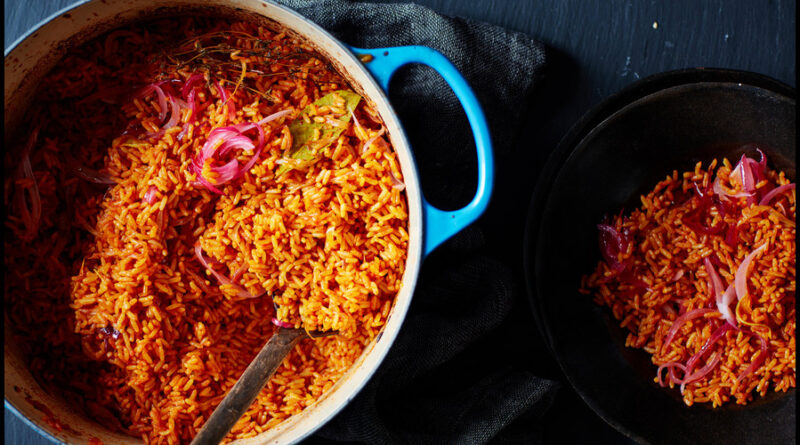Cost of Cooking Jollof in Nigeria Drops for First Time in Nearly 8 Years
…falls to N26,256 in September amid easing inflation
The average cost of preparing a pot of jollof rice for a Nigerian family of five dropped in September for the first time in seven years and eight months, according to Markets Reporters’ analysis of the new data from SBM Intelligence.
Despite the decline, a minimum wage earner still spends 34.1% of their N77,000 monthly salary to cook the popular Nigerian delicacy, underscoring the depth of the country’s cost-of-living crisis.
The quarterly jollof index report, titled ‘A Tale of Two Economies’, by SBM Intelligence — an Africa-focused geopolitical research and strategic communications firm — shows that the cost of jollof fell by 3.17% over the quarter to N26,656 in September.
The last time Africa’s most populous nation saw a decline in the index was in February 2018, when the cost dropped to N5,566 from N5,627 in January.
Link to inflation and government interventions
The decline aligns with easing food inflation, which accounts for more than half of Nigeria’s inflation basket. According to data from the National Bureau of Statistics, the general price level fell by 1.57% month-on-month to 16.87% in September—the slowest pace since September 2020 under the old methodology.
Nigeria’s headline inflation also eased for the sixth consecutive month, declining to 18.02% in September from 20.1% in August.
The naira has rallied to its strongest level in eight months, climbing from ₦1,529.73/$1 on June 30, 2025, to ₦1,480.3/$1 on September 26, according to data from the central bank.
“The easing momentum is partially credited to government interventions, notably import waivers for key food items, which improved market supply, and a more stable naira, which helped curb the cost of imported inputs,” the SBM report said.
However, it cautioned that the relief may be short-lived: “The temporal pattern of price relief indicates a deep structural challenge; the price moderation is overwhelmingly tied to the timing of seasonal supply arrival and early harvest yields, rather than systematic improvements in logistics or security,” it added.
The Jollof index tracks price changes across 13 markets in Nigeria’s six geopolitical zones, using the cost of ingredients such as rice, groundnut oil, chicken or turkey, beef, seasoning, pepper, tomatoes, salt, and onions. It excludes December due to seasonal variations.
Since its launch in 2016, the index has closely mirrored food inflation and provided a relatable measure of the cost-of-living crisis for ordinary Nigerians.
Regional price trends: Bauchi drops, Kano rises
Bauchi, one of Q2’s inflation hotspots, saw a massive 15% correction in Q3, with the index falling from N41,050 to N34,750. SBM said the sharp drop reflected “a localised influx of early harvest yields following a period of hyper-inflated prices or a demand collapse after previously unsustainable highs.”
In contrast, Kano, a key Northwestern trade hub, recorded a 6.83% increase to N30,950 in September.
“Reports indicate that local market dynamics, such as the diversion of local rice harvest for more profitable inter-state trade or export, and the use of ‘old stock’ narratives to resist price decreases, exacerbate local scarcity and price spikes,” SBM explained.
Despite its strategic advantage as a port city, Port Harcourt also saw a 1.84% rise to ₦33,200 in Q3.
A local wholesaler cited “poor road conditions, insecurity, and transport costs” as major reasons the port advantage hasn’t translated into affordability.
Hunger worsening despite price moderation
Even with the easing of food prices, hunger levels in Africa’s fourth biggest economy remain alarming. The latest Global Hunger Index (GHI) ranks it 115th out of 123 nations, placing it in the “serious” category.
The World Health Organization report noted that Nigeria is the second country in West Africa within the “serious food crisis” zone.
Analysts at CSL Research said in a note on Tuesday that the GHI findings reflect the deepening food insecurity affecting millions of Nigerians. “Alarmingly, over 31.8 million Nigerians are now grappling with acute food insecurity, with the situation projected to deteriorate further without urgent intervention.”
Ghana’s jollof cost rises despite strong currency
Across the border, Ghana’s average index grew from GH¢420 in June to GH¢430.8 in September.
The rise came despite the country’s cedi becoming the world’s best-performing currency in April 2025, reversing its 2023–2024 slump. According to the World Bank, the cedi remains Africa’s strongest currency eight months into 2025.
The currency’s appreciation has helped bring headline inflation down to 9.4% in September, its lowest since 2021, offering relief to households and businesses.
“This marginal reversal in the Jollof Index, particularly the sharp spike in September, highlights Ghana’s acute vulnerability to external commodity volatility and reliance on imported staples,” the report said.
“Policy success remains geographically limited. Ghana’s North East Region recorded a severe 20.1 percent inflation rate, more than double the national average, underscoring that macroeconomic stability has not reached all citizens,” it added.
Nigeria’s structural problem vs. Ghana’s policy gap
While Ghana grapples with regional inflation inequality, Nigeria faces structural supply-side collapse that continues to drive food insecurity.
“Policy efforts must decisively shift focus, viewing security provision in food-producing and transit regions not as a discretionary expense, but as foundational economic infrastructure,” SBM said.
It warned that without addressing insecurity—which adds a 20–30% risk premium to the movement of goods—efforts at agricultural mechanisation or subsidy programmes will “inevitably fail.”
For Ghana, SBM urged policymakers to sustain fiscal and monetary discipline while addressing regional disparities.
“This requires targeted, substantial investment in the Northern region’s road infrastructure to close the 20.1% inflation gap and ensure national policy relief reaches inland areas, effectively removing the ‘silent tax’ imposed by poor road networks,” it said.




